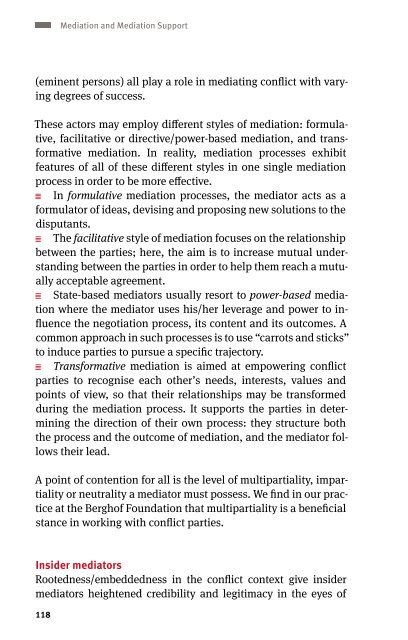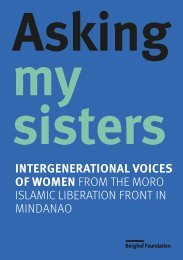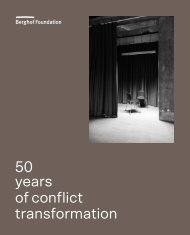Berghof Glossary on Conflict Transformation
The Berghof Glossary on Conflict Transformation presents 20 of the main principles and approaches used by the Berghof Foundation in its work. It is a concise and accessible exploration of what it takes to create “space for conflict transformation”. 2019 edition.
The Berghof Glossary on Conflict Transformation presents 20 of the main principles and approaches used by the Berghof Foundation in its work. It is a concise and accessible exploration of what it takes to create “space for conflict transformation”. 2019 edition.
Create successful ePaper yourself
Turn your PDF publications into a flip-book with our unique Google optimized e-Paper software.
Mediati<strong>on</strong> and Mediati<strong>on</strong> Support<br />
(eminent pers<strong>on</strong>s) all play a role in mediating c<strong>on</strong>flict with varying<br />
degrees of success.<br />
These actors may employ different styles of mediati<strong>on</strong>: formulative,<br />
facilitative or directive/power-based mediati<strong>on</strong>, and transformative<br />
mediati<strong>on</strong>. In reality, mediati<strong>on</strong> processes exhibit<br />
features of all of these different styles in <strong>on</strong>e single mediati<strong>on</strong><br />
process in order to be more effective.<br />
In formulative mediati<strong>on</strong> processes, the mediator acts as a<br />
formulator of ideas, devising and proposing new soluti<strong>on</strong>s to the<br />
disputants.<br />
The facilitative style of mediati<strong>on</strong> focuses <strong>on</strong> the relati<strong>on</strong>ship<br />
between the parties; here, the aim is to increase mutual understanding<br />
between the parties in order to help them reach a mutually<br />
acceptable agreement.<br />
State-based mediators usually resort to power-based mediati<strong>on</strong><br />
where the mediator uses his/her leverage and power to influence<br />
the negotiati<strong>on</strong> process, its c<strong>on</strong>tent and its outcomes. A<br />
comm<strong>on</strong> approach in such processes is to use “carrots and sticks”<br />
to induce parties to pursue a specific trajectory.<br />
Transformative mediati<strong>on</strong> is aimed at empowering c<strong>on</strong>flict<br />
parties to recognise each other’s needs, interests, values and<br />
points of view, so that their relati<strong>on</strong>ships may be transformed<br />
during the mediati<strong>on</strong> process. It supports the parties in determining<br />
the directi<strong>on</strong> of their own process: they structure both<br />
the process and the outcome of mediati<strong>on</strong>, and the mediator follows<br />
their lead.<br />
A point of c<strong>on</strong>tenti<strong>on</strong> for all is the level of multipartiality, impartiality<br />
or neutrality a mediator must possess. We find in our practice<br />
at the <str<strong>on</strong>g>Berghof</str<strong>on</strong>g> Foundati<strong>on</strong> that multipartiality is a beneficial<br />
stance in working with c<strong>on</strong>flict parties.<br />
Insider mediators<br />
Rootedness/embeddedness in the c<strong>on</strong>flict c<strong>on</strong>text give insider<br />
mediators heightened credibility and legitimacy in the eyes of<br />
118










